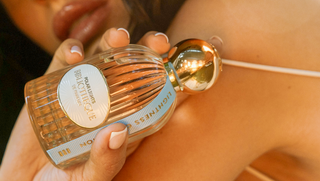In perfumery, there are notes that have no direct source in nature. They are born not from flowers or resins, but from the idea of conveying a feeling. The Champagne note is precisely one of these — ephemeral and multi-layered.
From Beverage to Molecule
The attempt to "translate" Champagne into the language of fragrance first appeared in the mid-20th century when perfumers began working with synthetic compounds, particularly aldehydes. These molecules allowed them to create the effect of fizz, transparency, and "airy chill" reminiscent of the first seconds after a sparkling wine bottle is opened.
The note is created using a combination of aldehydes, citrus essences, green tea, white musk, and fruity accords. Together, they generate a "bubble effect"— a scent that has no weight, but still fills the space.
The Sparkling Variety
Depending on the artistic concept, the Champagne note can smell very different:
Women’s Fragrances, it is created using aldehydes and fruit esters (peach, nectarine, pear) to achieve a sensation of sparkles on the skin — a light sweetness with a cool citrus undertone. This interpretation gives the composition an "airy brilliance" and has the ability to amplify the radiance of white flowers.

In Men’s Fragrances, the Champagne note sounds "drier": the foundation consists of green tea, bergamot, and woody musks. This creates a cooling effect — like the first sip of sparkling wine in winter air – lending the composition a metallic, clean edge.
In Unisex Compositions, the focus shifts to the contrast of textures: aldehydes are blended with warm accords of vanilla, cream, or mahogany, forming a complex balance between cool freshness and delicate softness. This effect is often perceived as a "silky fizz."
To convey the illusion of Champagne, perfumers use several techniques:
-
Aldehydes C-10 and C-12 — create the characteristic "fizz" similar to bubbles.
-
Notes of white musk and green apple — add cleanliness and freshness.
-
Fruity accords (peach, apricot, nectarine) — create a soft, sweet depth that balances the acidity.
-
Woody-creamy base (sandalwood, cedar, cream) — fixes the "sparkling" sound and makes it last longer on the skin.
This note has no exact chemical formula counterpart — every perfumer has their own "recipe for sparks."
Champagne at Bibliothèque de Parfum
Among the fragrances at Bibliothèque de Parfum, the Champagne note rings out particularly distinctly in Polar Lights. It opens the composition, setting the very effervescent mood that begins the story of Igor and Kaitlyn—the characters who journeyed to the Arctic Circle to find their light.
“Oh, wait, I have something.”
He pulled a bottle of Champagne, two glasses, apricots, peaches, and even a small bouquet of grass that smelled of July, out of his backpack
“This is to our summer. Happy year, my dear…”
Read the full story of Polar Lights on the fragrance page.


